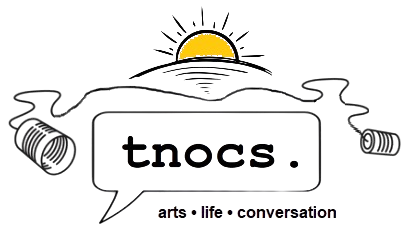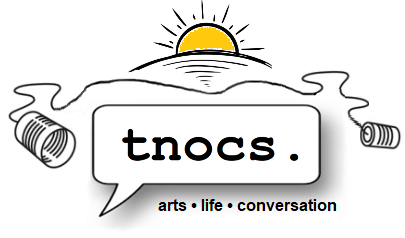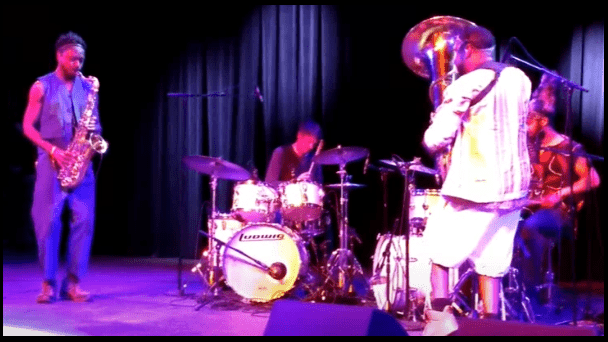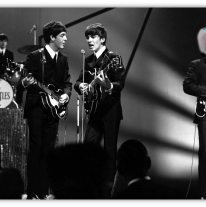I love to dance. I never learned any real dance steps, per se, but I can move well and rhythmically.
I’m not always too embarrassed to do it out in public either. A favorite memory of the 2015 Big Ears festival was the late-night set by Omar Souleyman – now that was a dance extravaganza! The whole floor was jumping up and down. I was hoping for a similar experience this time, and Saturday night seemed like the most likely possibility. But that would be at the end of a very long day.
Looking at the schedule, I realized that the lead singer from Balún (the Latin American roots / dream pop band I saw on the first day) was doing her own solo set for Friday lunch. So I found myself at the small Performing Arts center and caught the second half of Angélica Negrón’s show. This performance was very vocal-centered and often ethereal, with no rhythmic underpinning. On the other hand, some songs did have a solid rhythm track, courtesy of a button she pressed on a sampler or a keyboard or something.
There was one really nice angle at Angélica Negrón’s performance. There was a row of various houseplants and flowers prominently displayed. They were on a table on the stage, and Ms Negrón stood behind them for most of her performance. At first this just seemed eccentric, and it wasn’t immediately obvious what she was doing. The music itself can be very ambiguous, with vocal effects and loops on top of synth effects and samplers and other electronic paraphernalia.
I kept noticing her reaching out and touching the plants, sometimes in quick sequences from one plant to another. The tones that were being generated started to rise in my awareness, and I looked more closely and saw that the plants and flowers had electrodes clipped to them! Gradually, I sussed out what was going on: she was literally playing the plants by touching them. I’ve heard of such things in vague terms before, but I’d certainly never seen it done live.
According to some random person whom I talked with about it after the show, the electrical signals from the plants are processed by some program and that’s where the different tones come from. I was hoping it was more direct, like if the different tones were inherent to the different plants – a begonia sounds like this, whereas a tulip sounds like this – but still, it was a remarkable thing to see.
I wanted to get a printed festival program – I was a bit lost without a street map – I went to the festival headquarters, which was located inside an overhauled train terminal. I didn’t get a program, but I did get to hear an unexpectedly awesome band called Dos Santos. They’re based in Chicago but their roots are in Latin America, and they sound like a punchier, crunchier version of Los Lobos. In an ideal world, every music festival- goer would have a moment like this, when you’re surprisingly wowed by an act that was not on your radar. Dos Santos did that for me.
A John Zorn event was added to the schedule – an interview with him at the nearby Museum of Art. I’d had another act in mind for that timeslot, but they were immediately eliminated – sorry, Bang On a Can All-Stars… That’s the way it is with big music festivals. Tough decisions have to be made. I wasn’t going to pass up my first chance to see Zorn in person, but the timeslot also pushed uncomfortably up against the Sons of Kemet show, which was about a mile away. That show was guaranteed to be packed, and I wanted to get a good view.
I’d planned for one small culinary splurge – I wanted to get an anchovy/pesto pizza while in town. I was happy to learn that I could get that at Tomato Head, a long-time anchor of the Knox hip eatery scene. I opted for the 9-inch instead of the big one, which was a bit of a tactical blunder. But the pizza hit the spot and did its job well enough. I had a bit of time so I decided to check out Caroline Shaw playing with Sō Percussion. I stayed for a couple of selections and remember little about it, except for a nagging feeling that I should head over the Art Museum in time to get there early for the Zorn interview.
That was another good instinct on my part. When I got there, half an hour early according to the schedule, I found that the interview had already started and was more than halfway through. Sometimes Zorn takes questions from the audience after interviews (on the rare occasions that he does interviews). He didn’t take questions at Big Ears, though, so I didn’t get to ask him my ultra-insightful question about which of the Masada books he was going to be picking songs from. But I did get to be the first to accost him with a handshake and a few moments of effusive praise as soon as the interview was over. And I felt like that was enough.
A bit later in the day it occurred to me that, although in lower Appalachia an uncomfortably forward handshake is meant as a great compliment, I was maybe being a little too, um, heavy-handed.
Most of Zorn’s crew is from NYC, which is considerably more strict about C19 protocols than aw-shucks Tennessee is. These guys might not have shaken anyone’s hand in months or longer. They probably didn’t want random fans insisting on poor etiquette. I decided that bumping elbows would be a much better way to go.
The upside of Zorn’s interview going early was that I had ample time to get to the next venue – the same one where I saw Bill Callahan the first night – and get situated. Tonight’s show wouldn’t involve any old-fogey chairs sitting along the wall. Sons of Kemet was the one show of the festival that I was totally willing and ready to stand for: standing near the gate until they opened the floor, then getting as close to the front as possible. One of the advantages of having a relatively small frame is being able to fit into small spaces. I found myself flowing like water, forward into empty spots, until I was eventually able to secure a hold on the metal barricade in front of the stage.
Sons of Kemet are a London-based happening, centered around Shabaka Hutchings, the main creative force behind this band and at least a couple other ensembles. In short, Shabaka Hutchings is the current hotshit of the UK Jazz scene. The lineup for Sons of Kemet is, in my mind, gob-smackingly brilliant: Hutchings plays saxophone (and sometimes flute), and there’s a tuba player. There are two other musicians (and here’s the brilliant part). Rather than a having a guitar, or a piano, or a bass – you know, the standard choices – the other two players are both drummers / percussionists!
A lineup of two horns and two drummers is unusual, to say the least. Right off, I don’t know of any other examples. In a philosophical mood, I would argue that that lineup itself knocks on some primal, elemental doors. And Sons of Kemet play with urgency and intensity. Even without vocals it sounds like aggressive, revolution-minded music. Their records do generally feature some guest vocals mixed in with the instrumentals, and the vocals leave no doubt about the confrontational nature of the music. For Big Ears there were no vocals, and they weren’t missed. The sound generated by the four guys and their instruments was huge, and made most pre-programmed rhythm tracks sound like a pile of puke.
It occurred to me that there are some parallels between Shabaka Hutchings and John Zorn. Hutchings seems to have some of Zorn’s vision and drive, along with a gift for bringing musicians together to play. It may be fascinating to see where Mr Hutchings takes his music in the coming years.
Afterward, I was able to catch a bit of beatboxer / vocal artist Shodekeh’s solo spot. This was more like a demonstration and seminar. He talked about the process of what he does and encouraged the audience to give it a try, which accorded well with his background as an innovator and educator. He’s actually been at it for 30+ years and has held positions at multiple universities, making him an accomplished, if undersung, talent.
I intended to make the solo show by Kim Gordon, formerly of Sonic Youth, my next stop. Seeing her perform wasn’t a major priority overall, but my buddy back home had asked me to be on the lookout for her merch. Plus, she’s sexy in an iconic NYC-cool kind of way, and I knew those theatre seats were going to be comfortable. The line outside was long, though, and didn’t move until the scheduled start time was looming. Getting in the doors was a move in the right direction, but then everyone was kept herded in the lobby until after the official start time.
I understand a tiny bit about running big events like this, and how one act going long or having any type of issue can have a domino effect that throws off the whole operation. So I maintained my patience – briefly. But once we were let in and I took a seat, I was dismayed to see that the stage hands were still moving monitors around and – get this – tuning the guitars at 20 minutes past the schedule start up time. It was then that I lost my patience.
It’s possible that I was being a little overly cranky because my back was sore and I’d been out in the cold and wind for longer than I liked. Of course the obvious thing to do in that situation was to leave my warm, comfortable seat close to the stage and head back out and towards a different venue – but NOT before complaining loudly to the uninterested stranger sitting close by, and then storming out with a proudly-proclaimed, “Kim Gordon can kiss my ass!” echoing in my wake.
(A Disclaimer: No echo or actual wake was generated.)
It was only the second day of the festival but I was already feeling spent, not to mention fussy. I had pinned my booty- shaking hopes on Lido Pimienta, a Colombia-born, Canada-based force of Nature. But sadly, my spirit was all that got shaken. Another windy, cold line greeted my at the club, another line that seemed to be frozen in place. To make matters worse, by the time the doors were opened I felt like I personally had been frozen in place.
My hopes for a dance throwdown were dwindling.
From what I heard, Ms Pimienta possesses an exceptionally strong voice and an admirable habit of being blunt and fearless. She has a commanding stage presence and a capability of bellowing in a convincing death metal growl, which, punctuated by the strobe light and for only eight measures, is incredibly satisfying. She also had a percussionist on stage who played a variety of drums, and seemed to be playing the heck out of them. But the drummer was the only other musician on stage. Otherwise, the backing music magically appeared when the singer pressed a mysterious button.
I did my share of complaining about rhythm tracks and such for the first day’s write-up, and I know a dead horse when I smell one. Suffice to say, I called it a night after a few songs from Lido Pimienta and went back to the room feeling utterly spent and a bit dejected.
Later I realized that it was pretty stupid to feel down about the day I got to see Sons of Kemet play, right after meeting John Zorn!
But the physical demands of the festival were hard to ignore, and the next day was going to make that even more painfully clear… (to be continued…)
Let the author know you liked their article by clicking a “heart” upvote!






What a day, BG! Sounds exhilarating and exhausting. I would’ve been so stoked to see Sons of Kemet live. Color me jealous.
I’m not familiar with Sons of Kemet but now I want to see them, too!
I had “Pick Up Your Burning Cross” on my 2021 year in review mix tape. Everything I’ve heard from Sons of Kemet is so vital and unexpected. I think you’ll dig them V-dog, in spite of their lack of bass.
https://youtu.be/Dw_YbYpOPzo
Cool PS, hadn’t seen that video. Here’s the one that sold me on the album:
https://www.youtube.com/watch?v=EDepEUnJwpY
Ryan Leas’ Stereogum write-up was pretty convincing too, the latest album was named album of the week:
https://www.stereogum.com/2146886/sons-of-kemet-black-to-the-future/reviews/album-of-the-week/
Same. I love live music, and even musicians whose recorded work doesn’t really speak to me can be fun live. I don’t know whether Sons of Kemet fits that category, as I have not had a chance to dig into their recorded work, but I intend to do that.
A Sons of Kemet clip from the festival:
https://www.youtube.com/watch?v=i9lJguW7Xvc
Sounds like this festival is essentially one continuous “I would’ve never thought someone could do that musically, that’s so cool” exclamation!!
Ok, just me saying it constantly.
Totally get your comment about out of town folks getting weirded out still post covid. Where I live in a more rural area, it’s been an afterthought for nearly a year now. As far as we’re concerned we’ve been ‘back to normal’ for awhile, but I’ve also been max teleworking over 2 years now. We’re finally going back into the office in 2 weeks, so I have to start practicing to be on my best behavior returning to DC!!!
Going back to the office after 2 years! How do you feel about that? I think I’d be resistant to it…
My employer is trying to get us back into the office as well, and I’m definitely resistant. The only advantage they’ve cited is being able to bounce ideas off your co-workers. That’s fine if you’re an executive decision maker, but I write software. If I need an idea, I’ll Google it. If I do need to talk to a co-worker, developers prefer email and Webex so they can share code and not be interrupted when deep in thought by some guy coming into their cube. There’s zero benefit for me to be in the office except for the building’s real estate value.
Sorry, was I ranting?
I just started back part time in the office. Today’s my 2nd day in two years (yesterday was the first). Many people not back yet but besides the empty offices it’s pretty similar to before times. It’s a lot easier to park but the coffee and pastry place next door closed down…
Q: Of all the jobs in the United States and in Europe, what percentage can be performed completely via working remotely?
A: 37% and 31%.
Research shows that 31 percent of jobs in Europe and 37 percent of jobs in the United States can be done remotely.
Source: Boeri, Caiumi, Paccagnella: Mitigating the work-safety trade-off, (2020)”
I thought the move towards remote work was one of the good things to come out of the pandemic. It’s a bit disheartening to learn that companies are now wanting employees to come back. If remote work has been getting the job done, more or less, for two years now, it seems like there’s something besides productivity or worker satisfaction motivating the companies to insist that workers return to an office.
I started a new job in the fall of 2019, just in time to be declared an Essential Worker and work in the public throughout the pandemic. Or rather, until a couple of months ago when I started a remote job answering incoming calls, and making several dollars more per hour. I’m not saying it’s a perfect job – in fact they’ve already pissed me right off – but I’m enjoying the work from home aspect. I’ll stick with remote work if possible.
I don’t know how I feel about the whole home/office debate. I was only at home from March-June of 2020. I went back to my office at school before the start of the 2020-21 school year since I had my own office, and that was six months before the kids returned. Almost 100% of our community is back now (there are fewer than 60 kids who are in our “virtual academy” for the rest of this school year, and it will be shut down after that by state mandate). In theory, my job is one that could be done from home. In practice, it feels like more kids suffered from the virtual learning year than those who benefited from it (although in many cases the kids who benefited from it struggle in the traditional environment).
I can definitely see that a lot of kids suffered from virtual learning. For a few who are advanced and have good self-discipline, it was great. They could do their work and move on without waiting for others to catch up. For a few who struggle with social issues or certain mental health issues, it was great. Eased their anxiety quite a bit. For the rest, not so good. Delayed learners were especially hurt. There was also the question of adequate nutrition. Providing two extra meals per day was quite taxing for many families, especially those who also lost income due to the pandemic.